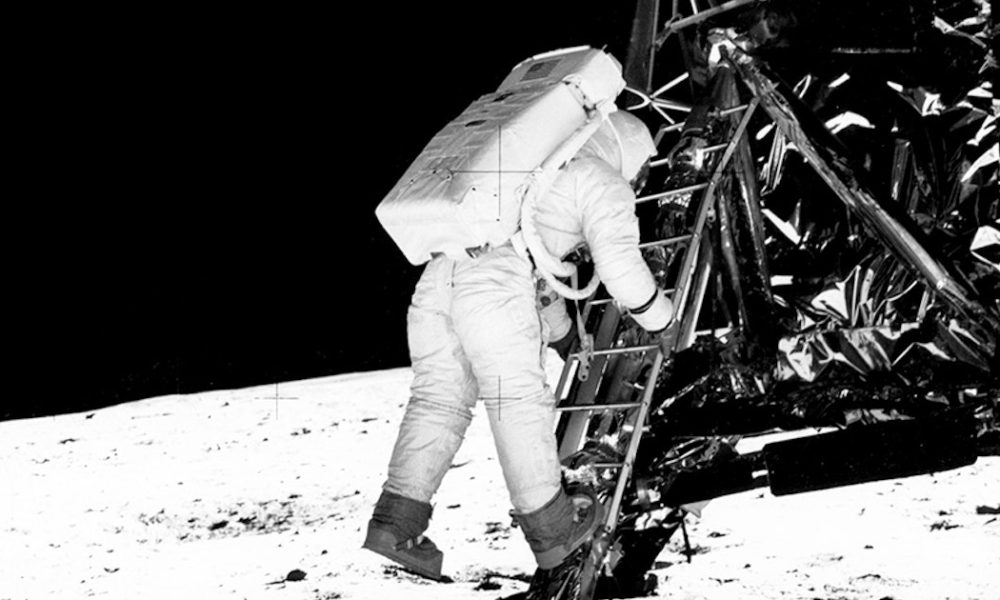 Man on the Moon, July, 21, 1969. Photo provided/NASA
Man on the Moon, July, 21, 1969. Photo provided/NASA
Purists will complain that the title of this column is an abbreviation of the first words spoken from the moon’s surface. I grant that claim and wish to point out that this condensation has become an idiom in our modern usage.
While Neil Armstrong’s voice sounded calm and collected, his words were a verbal confirmation that the astronauts had in fact survived the landing.
What had led up to these historic words were a nail-biting few minutes as the Lunar Module, code-named Eagle, encountered numerous problems on its descent.
Astronauts Armstrong and Edwin ”Buzz” Aldrin had noticed they were seeing guidance landmarks early. This indicated they were approaching the lunar surface too fast, making them go ”long” for a landing. The computer-guided landing site was a boulder-strewn field, causing Armstrong to take over and fly manually.
Additionally, the computer kept issuing a warning code. While this didn’t affect the computer’s overall operation, it certainly was a distraction.
Finally, with less than a minute’s worth of fuel left, Armstrong piloted the lander into a successful landing. After completing their touchdown checklist, Neil Armstrong spoke these words: ”Houston, Tranquility Base here. the Eagle has landed.”
I was 14 when I heard those words, live. It was pretty special to me. The quest for a moon landing was something that had been a part of my life for as long as I could remember.
Having grown up in Florida gave it a sort of a personal connection, as the rockets blasted off from Cape Kennedy. Cape Canaveral had been renamed to honor the man who had set the whole thing in motion while tragically not having lived to experience its successful outcome.
This all came about due to a Russian satellite named Sputnik 1; it shocked a nation when our Cold War enemy pulled one off over the USA by being the country to move ahead in the space race.
President Kennedy ramped up the space program begun under Eisenhower. in 1961, he famously declared that we would land a man on the Moon and bring him home safely before the decade was out. This would require a tremendous investment of taxpayer money to accomplish and the approval of Congress, not to mention some hitherto-undeveloped rocket craft. But the fear of being beaten by the communist Soviet Union, and the possibility the USSR gaining a military advantage pushed the program through and gave the nation a new purpose.
My earliest space memory was seeing Alan Shepard, the first American in space, blast off on the television set Mrs. Brock had brought into the first grade classroom.
Soon, I started seeing plans for a space capsule that would carry a three-man team of astronauts in my Weekly Reader. There would be another five missions of Project Mercury that carried only a single astronaut into space.
As more was learned, larger rockets capable of carrying a bigger capsule and more astronauts into space were developed. Next came Project Gemini, which carried two astronauts, and this program would develop the crucial skill of navigating to a docking target and the ability to connect to another moving craft. Also the gentle art of spacewalking.
The planned first Apollo mission ended in tragedy when all three astronauts died during a training exercise when a fire erupted in the 100%-oxygen environment of the sealed capsule. While the nation grieved, the engineers dug through the wreckage to figure out how to never let this happen again. When the team was convinced that it was safe to proceed, the program continued.
As the progressive Apollo missions practiced a trip to the moon, docking to the lunar lander and other necessary skills, the national interest grew.
I had a paper model lunar lander (LEM) dangling from my ceiling that had come from the gas station and was painstakingly cut out, folded, connected and taped together. Many such promotional items were offered by businesses seeking to capitalize on the public’s focus on the moment when we would be the first on the moon.
The long-awaited moment came on the day we got back from my grandmother’s (she only lived 50 miles away). They had landed that evening, but the long preparations made it hard for us to wait patiently for the big event.
At last, at about one o’clock in the morning, we could see the grainy picture of Neil Armstrong coming down the ladder. It was hard to make out when he actually touched the surface. The landing pad had to be negotiated, but then history was made.
A bit later, Aldrin joined him and they set up a camera that had a slightly better image and we could see them bouncing about on the surface doing their tasks. It was almost anticlimactic and at the same time a very strange feeling.
There would be five more moon landings and one near miss with Apollo 13 (another event that I experienced live and not in the movie) before the program was prematurely cut short.
I do have one regret from it all. Several of my friends made the 4.5-hour trip over to the Kennedy Space Center and got to experience the immense power of the liftoff of the most powerful rocket ever to blast off. They described the sound and vibrations from the Saturn V Rocket as it lifted off carrying a 34,000-pound payload and three humans into space.
Years after the Apollo program was over I visited the Space Museum there at the Cape, and standing next to a section of the huge rocket was a humbling experience. Wish I could have seen one go up. Oh well, next time!
I wonder whether there will ever be something like that ”One small step” which captured the attention of the nation and the world that night 50 years ago?
Dana Merryday 541-942-7037, 205 Adams Ave, Cottage Grove [email protected]








